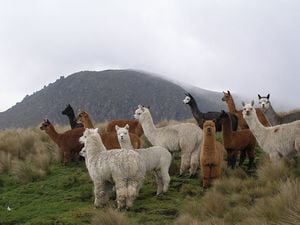Alpaca experience planned
A soothing touch of South America could be coming to Mid Wales.

A proposal has been submitted to Powys County Council for an “Alpaca Experience” business near Meifod.
Applicant, Helen Cooksley of Maesnewydd has submitted a planning application to change the use of a barn at her property so that it becomes a classroom, and to build another barn so that she can keep more Alpacas.
Miss Cooksley explains her proposal in a design and access statement which reveals that she already has six Alpacas at the small holding, and hopes to grow a bigger herd.
She said: “The planning application is for a the creation of a small alpaca business which includes the proposed change of use of an old milking barn into a classroom, a new shelter to house the alpacas and their food.”
“The business mode is based around health and wellbeing to support those with long term issues, pain management, depression and anxiety to experience relaxing and calming with the Alpacas in an open spaced natural environment that promotes relaxation and calm.”
Miss Cooksley said that alpacas are perfect for calming people as they have “slow movements”, the small holding also commands “amazing views” of the Vyrnwy valley which she says would also help.
Visitors could take the creatures for walks and feed them.
Miss Cooksley said that she would also give weaving as well as yoga and meditation classes as part of the “experience.”
She believes that clothing and soft furnishings produced from Alpaca fleece such as scarves, shawls, cushions and other garments could be sold online.
“Our shelter is big enough for a maximum of six alpacas, as the herd grows we require a second shelter,” said Miss Cooksley.
Alpacas come from South America and are distantly related to camels, but are much smaller, adults are usually less than a metre tall.
They are kept in herds that graze on the level heights of the Andes of Southern Pery, Western Bolivia, Ecuador and Northern Chile at an altitude of 3,500 to 5,000 metres above sea level.
They have been bred for their fleeces for around 5,000 years, as it has been found that the fibre is naturally water and fire resistant.





